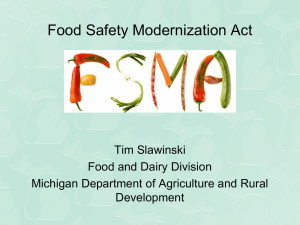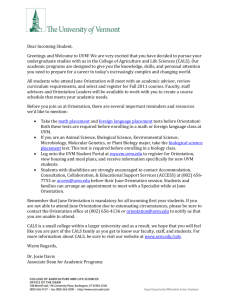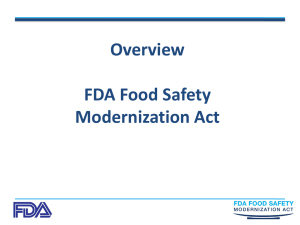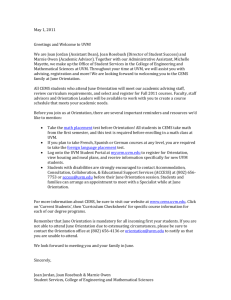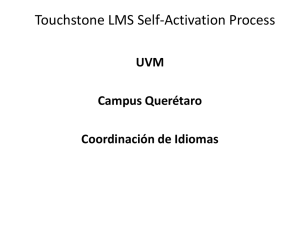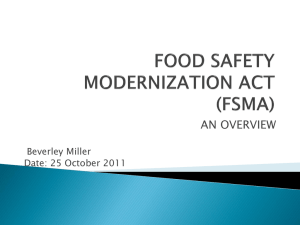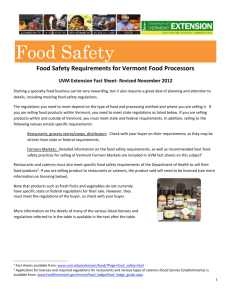FSMA preventative controls fact sheet_final
advertisement
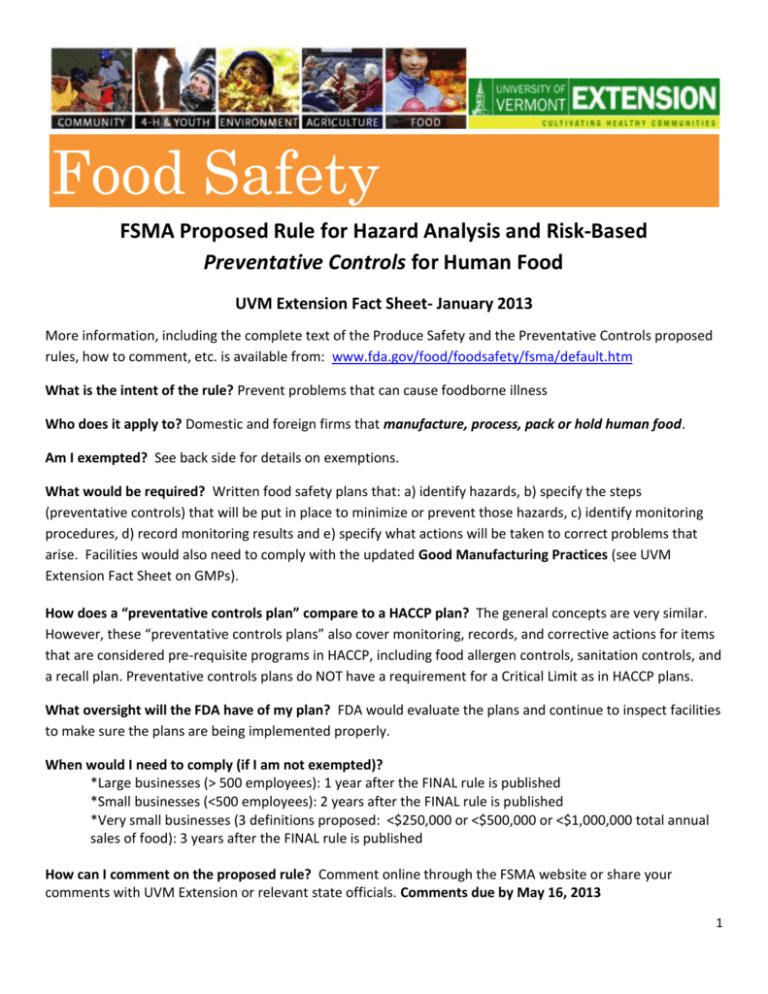
Food Safety FSMA Proposed Rule for Hazard Analysis and Risk-Based Preventative Controls for Human Food UVM Extension Fact Sheet- January 2013 More information, including the complete text of the Produce Safety and the Preventative Controls proposed rules, how to comment, etc. is available from: www.fda.gov/food/foodsafety/fsma/default.htm What is the intent of the rule? Prevent problems that can cause foodborne illness Who does it apply to? Domestic and foreign firms that manufacture, process, pack or hold human food. Am I exempted? See back side for details on exemptions. What would be required? Written food safety plans that: a) identify hazards, b) specify the steps (preventative controls) that will be put in place to minimize or prevent those hazards, c) identify monitoring procedures, d) record monitoring results and e) specify what actions will be taken to correct problems that arise. Facilities would also need to comply with the updated Good Manufacturing Practices (see UVM Extension Fact Sheet on GMPs). How does a “preventative controls plan” compare to a HACCP plan? The general concepts are very similar. However, these “preventative controls plans” also cover monitoring, records, and corrective actions for items that are considered pre-requisite programs in HACCP, including food allergen controls, sanitation controls, and a recall plan. Preventative controls plans do NOT have a requirement for a Critical Limit as in HACCP plans. What oversight will the FDA have of my plan? FDA would evaluate the plans and continue to inspect facilities to make sure the plans are being implemented properly. When would I need to comply (if I am not exempted)? *Large businesses (> 500 employees): 1 year after the FINAL rule is published *Small businesses (<500 employees): 2 years after the FINAL rule is published *Very small businesses (3 definitions proposed: <$250,000 or <$500,000 or <$1,000,000 total annual sales of food): 3 years after the FINAL rule is published How can I comment on the proposed rule? Comment online through the FSMA website or share your comments with UVM Extension or relevant state officials. Comments due by May 16, 2013 1 Exemptions and Modified Requirements for Preventive Controls for Human Food* Hazard Analysis and Risk Based Preventive Control Requirements Current Good Manufacturing Practices (CGMP) Exempt Must comply Exempt Must comply A facility that has a) food sales averaging less than $500,000/ year in the last three years AND b) sales to qualified end users1 exceed sales to others. Facility must certify that it is implementing and monitoring preventive controls or complying with state laws. Must comply A very small business. Three definitions are being proposed: <$250,000, <$500,000, or <$1,000,000 in total annual sales of food. Facility must certify that it is implementing and monitoring preventive controls or complying with state laws. Must comply Type of facility or operation On-farm processing of jams and jellies and manufacturing honey and maple syrup Foods subject to FDA HACCP regulations (seafood and juice) Exempt from Preventative Controls. Activities within the definition of “farm” May be covered by Produce Safety (production of food) rule Warehouses only storing packaged foods that are not exposed to the environment Warehouses that store raw fruits and vegetables intended for further distribution or processing. If refrigeration is not required for safety: exempt. If refrigeration is required: temperature control records are required. Must comply* Exempt Must comply Exempt * Adapted from the FDA FSMA Chart. More information is available in the proposed rule available at: www.fda.gov/food/foodsafety/fsma/default.htm Note: your facility will lose its exempt status if it is determined that it was the source of a foodborne illness outbreak. Fact sheet prepared by Dr. Londa Nwadike, UVM Extension Food Safety Specialist, londa.nwadike@uvm.edu; tel: 802-223-2389; 617 Comstock Road, Berlin, VT 05602 Fact sheet reviewed by Dr. Ginger Nickerson, UVM Extension Center for Sustainable Agriculture GAPS/Produce Safety Outreach Coordinator UVM Extension helps individuals and communities put research-based knowledge to work. Issued in furtherance of Cooperative Extension work, Acts of May 8 and June 30, 1914, in cooperation with the United States Department of Agriculture. University of Vermont Extension, Burlington, Vermont. University of Vermont Extension, and U.S. Department of Agriculture, cooperating, offer education and employment to everyone without regard to race, color, national origin, gender, religion, age, disability, political beliefs, sexual orientation, and marital or familial status. 1 A qualified end-user is either a consumer (in any location), or a restaurant or retail food establishment purchasing the food for sale directly to consumers that is located in the same State or not more than 275 miles away. 2
